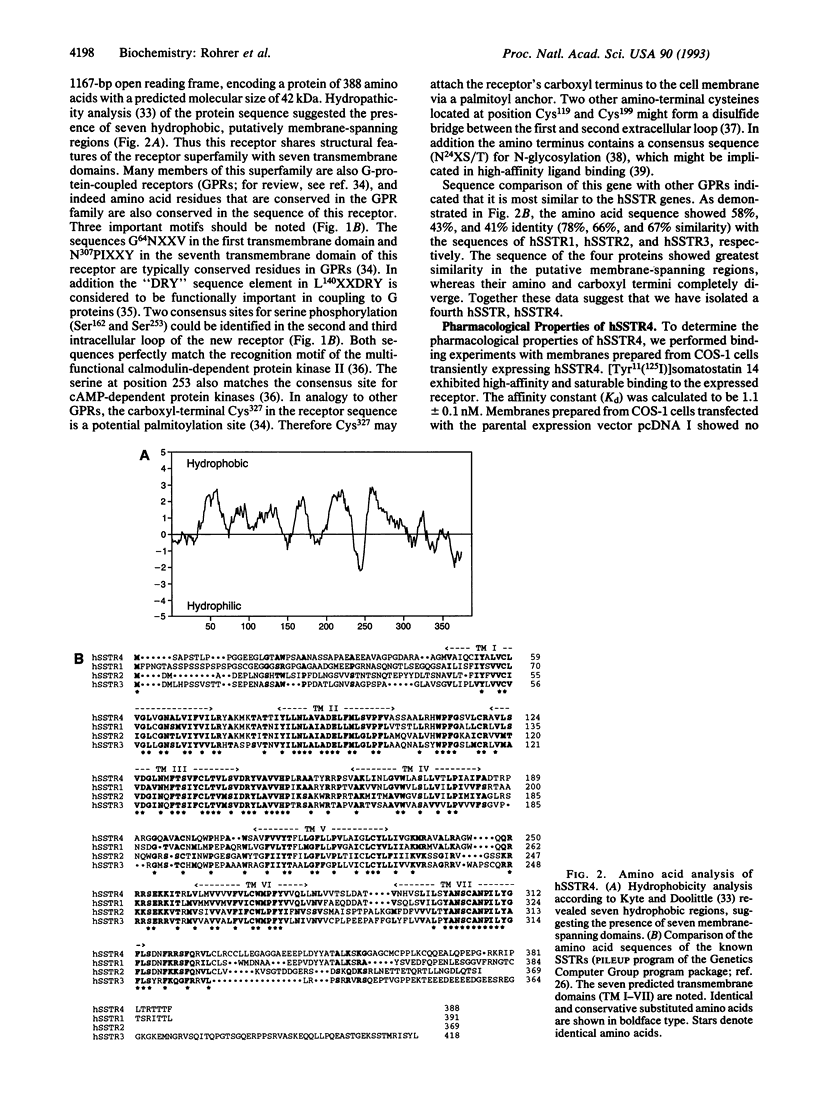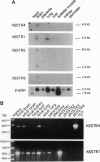Abstract
We have isolated a gene coding for a fourth human somatostatin (somatotropin release-inhibiting factor) receptor. This additional somatostatin receptor (hSSTR4) is specifically expressed in human fetal and adult brain and lung tissue. The deduced amino acid sequence of the receptor displays both sequence and structural homology to three cloned somatostatin receptors as well as to other members of the family of GTP-binding-protein-coupled seven-helix transmembrane-spanning receptors. Pharmacological characterization of the expressed receptor reveals specific, high-affinity binding of somatostatin 14 and somatostatin 28. Surprisingly, several well-characterized synthetic somatostatin analogs fail to exhibit high-affinity binding to hSSTR4, indicating the existence of pharmacologically different receptor subtypes. Our data suggest that the diverse biological effects exerted by somatostatin are mediated by a family of receptors with discrete patterns of expression and different pharmacological properties.
Full text
PDF




Images in this article
Selected References
These references are in PubMed. This may not be the complete list of references from this article.
- Bauer W., Briner U., Doepfner W., Haller R., Huguenin R., Marbach P., Petcher T. J., Pless SMS 201-995: a very potent and selective octapeptide analogue of somatostatin with prolonged action. Life Sci. 1982 Sep 13;31(11):1133–1140. doi: 10.1016/0024-3205(82)90087-x. [DOI] [PubMed] [Google Scholar]
- Brazeau P., Vale W., Burgus R., Ling N., Butcher M., Rivier J., Guillemin R. Hypothalamic polypeptide that inhibits the secretion of immunoreactive pituitary growth hormone. Science. 1973 Jan 5;179(4068):77–79. doi: 10.1126/science.179.4068.77. [DOI] [PubMed] [Google Scholar]
- Bruno J. F., Xu Y., Song J., Berelowitz M. Molecular cloning and functional expression of a brain-specific somatostatin receptor. Proc Natl Acad Sci U S A. 1992 Dec 1;89(23):11151–11155. doi: 10.1073/pnas.89.23.11151. [DOI] [PMC free article] [PubMed] [Google Scholar]
- Bruns C., Dietl M. M., Palacios J. M., Pless J. Identification and characterization of somatostatin receptors in neonatal rat long bones. Biochem J. 1990 Jan 1;265(1):39–44. doi: 10.1042/bj2650039. [DOI] [PMC free article] [PubMed] [Google Scholar]
- Cai R. Z., Szoke B., Lu R., Fu D., Redding T. W., Schally A. V. Synthesis and biological activity of highly potent octapeptide analogs of somatostatin. Proc Natl Acad Sci U S A. 1986 Mar;83(6):1896–1900. doi: 10.1073/pnas.83.6.1896. [DOI] [PMC free article] [PubMed] [Google Scholar]
- Devereux J., Haeberli P., Smithies O. A comprehensive set of sequence analysis programs for the VAX. Nucleic Acids Res. 1984 Jan 11;12(1 Pt 1):387–395. doi: 10.1093/nar/12.1part1.387. [DOI] [PMC free article] [PubMed] [Google Scholar]
- Epelbaum J. Somatostatin in the central nervous system: physiology and pathological modifications. Prog Neurobiol. 1986;27(1):63–100. doi: 10.1016/0301-0082(86)90012-2. [DOI] [PubMed] [Google Scholar]
- Fraser C. M., Chung F. Z., Wang C. D., Venter J. C. Site-directed mutagenesis of human beta-adrenergic receptors: substitution of aspartic acid-130 by asparagine produces a receptor with high-affinity agonist binding that is uncoupled from adenylate cyclase. Proc Natl Acad Sci U S A. 1988 Aug;85(15):5478–5482. doi: 10.1073/pnas.85.15.5478. [DOI] [PMC free article] [PubMed] [Google Scholar]
- He H. T., Rens-Domiano S., Martin J. M., Law S. F., Borislow S., Woolkalis M., Manning D., Reisine T. Solubilization of active somatostatin receptors from rat brain. Mol Pharmacol. 1990 May;37(5):614–621. [PubMed] [Google Scholar]
- Kemp B. E., Pearson R. B. Protein kinase recognition sequence motifs. Trends Biochem Sci. 1990 Sep;15(9):342–346. doi: 10.1016/0968-0004(90)90073-k. [DOI] [PubMed] [Google Scholar]
- Kluxen F. W., Bruns C., Lübbert H. Expression cloning of a rat brain somatostatin receptor cDNA. Proc Natl Acad Sci U S A. 1992 May 15;89(10):4618–4622. doi: 10.1073/pnas.89.10.4618. [DOI] [PMC free article] [PubMed] [Google Scholar]
- Kornfeld R., Kornfeld S. Assembly of asparagine-linked oligosaccharides. Annu Rev Biochem. 1985;54:631–664. doi: 10.1146/annurev.bi.54.070185.003215. [DOI] [PubMed] [Google Scholar]
- Kyte J., Doolittle R. F. A simple method for displaying the hydropathic character of a protein. J Mol Biol. 1982 May 5;157(1):105–132. doi: 10.1016/0022-2836(82)90515-0. [DOI] [PubMed] [Google Scholar]
- Lamberts S. W., Bakker W. H., Reubi J. C., Krenning E. P. Treatment with Sandostatin and in vivo localization of tumors with radiolabeled somatostatin analogs. Metabolism. 1990 Sep;39(9 Suppl 2):152–155. doi: 10.1016/0026-0495(90)90235-5. [DOI] [PubMed] [Google Scholar]
- Law S. F., Manning D., Reisine T. Identification of the subunits of GTP-binding proteins coupled to somatostatin receptors. J Biol Chem. 1991 Sep 25;266(27):17885–17897. [PubMed] [Google Scholar]
- Martin-Iverson M. T., Radke J. M., Vincent S. R. The effects of cysteamine on dopamine-mediated behaviors: evidence for dopamine-somatostatin interactions in the striatum. Pharmacol Biochem Behav. 1986 Jun;24(6):1707–1714. doi: 10.1016/0091-3057(86)90509-5. [DOI] [PubMed] [Google Scholar]
- Maurer R., Reubi J. C. Somatostatin receptors in the adrenal. Mol Cell Endocrinol. 1986 Apr;45(1):81–90. doi: 10.1016/0303-7207(86)90086-9. [DOI] [PubMed] [Google Scholar]
- O'Carroll A. M., Lolait S. J., König M., Mahan L. C. Molecular cloning and expression of a pituitary somatostatin receptor with preferential affinity for somatostatin-28. Mol Pharmacol. 1992 Dec;42(6):939–946. [PubMed] [Google Scholar]
- O'Dowd B. F., Hnatowich M., Caron M. G., Lefkowitz R. J., Bouvier M. Palmitoylation of the human beta 2-adrenergic receptor. Mutation of Cys341 in the carboxyl tail leads to an uncoupled nonpalmitoylated form of the receptor. J Biol Chem. 1989 May 5;264(13):7564–7569. [PubMed] [Google Scholar]
- Probst W. C., Snyder L. A., Schuster D. I., Brosius J., Sealfon S. C. Sequence alignment of the G-protein coupled receptor superfamily. DNA Cell Biol. 1992 Jan-Feb;11(1):1–20. doi: 10.1089/dna.1992.11.1. [DOI] [PubMed] [Google Scholar]
- Raynor K., Reisine T. Analogs of somatostatin selectively label distinct subtypes of somatostatin receptors in rat brain. J Pharmacol Exp Ther. 1989 Nov;251(2):510–517. [PubMed] [Google Scholar]
- Reichlin S. Somatostatin (second of two parts). N Engl J Med. 1983 Dec 22;309(25):1556–1563. doi: 10.1056/NEJM198312223092506. [DOI] [PubMed] [Google Scholar]
- Reisine T., Guild S. Pertussis toxin blocks somatostatin inhibition of calcium mobilization and reduces the affinity of somatostatin receptors for agonists. J Pharmacol Exp Ther. 1985 Dec;235(3):551–557. [PubMed] [Google Scholar]
- Rens-Domiano S., Reisine T. Structural analysis and functional role of the carbohydrate component of somatostatin receptors. J Biol Chem. 1991 Oct 25;266(30):20094–20102. [PubMed] [Google Scholar]
- Reubi J. C. Evidence for two somatostatin-14 receptor types in rat brain cortex. Neurosci Lett. 1984 Aug 31;49(3):259–263. doi: 10.1016/0304-3940(84)90299-4. [DOI] [PubMed] [Google Scholar]
- Reubi J. C. New specific radioligand for one subpopulation of brain somatostatin receptors. Life Sci. 1985 May 13;36(19):1829–1836. doi: 10.1016/0024-3205(85)90155-9. [DOI] [PubMed] [Google Scholar]
- Reubi J. C., Perrin M. H., Rivier J. E., Vale W. High affinity binding sites for a somatostatin-28 analog in rat brain. Life Sci. 1981 May 11;28(19):2191–2198. doi: 10.1016/0024-3205(81)90628-7. [DOI] [PubMed] [Google Scholar]
- Reubi J. C., Perrin M., Rivier J., Vale W. High affinity binding sites for somatostatin to rat pituitary. Biochem Biophys Res Commun. 1982 Apr 29;105(4):1538–1545. doi: 10.1016/0006-291x(82)90963-9. [DOI] [PubMed] [Google Scholar]
- Sakamoto C., Goldfine I. D., Williams J. A. The somatostatin receptor on isolated pancreatic acinar cell plasma membranes. Identification of subunit structure and direct regulation by cholecystokinin. J Biol Chem. 1984 Aug 10;259(15):9623–9627. [PubMed] [Google Scholar]
- Schally A. V. Oncological applications of somatostatin analogues. Cancer Res. 1988 Dec 15;48(24 Pt 1):6977–6985. [PubMed] [Google Scholar]
- Srikant C. B., Patel Y. C. Characterization of pituitary membrane receptors for somatostatin in the rat. Endocrinology. 1982 Jun;110(6):2138–2144. doi: 10.1210/endo-110-6-2138. [DOI] [PubMed] [Google Scholar]
- Srikant C. B., Patel Y. C. Somatostatin receptors: identification and characterization in rat brain membranes. Proc Natl Acad Sci U S A. 1981 Jun;78(6):3930–3934. doi: 10.1073/pnas.78.6.3930. [DOI] [PMC free article] [PubMed] [Google Scholar]
- Strosberg A. D. Structure/function relationship of proteins belonging to the family of receptors coupled to GTP-binding proteins. Eur J Biochem. 1991 Feb 26;196(1):1–10. doi: 10.1111/j.1432-1033.1991.tb15778.x. [DOI] [PubMed] [Google Scholar]
- Tabor S., Richardson C. C. DNA sequence analysis with a modified bacteriophage T7 DNA polymerase. Proc Natl Acad Sci U S A. 1987 Jul;84(14):4767–4771. doi: 10.1073/pnas.84.14.4767. [DOI] [PMC free article] [PubMed] [Google Scholar]
- Tran V. T., Beal M. F., Martin J. B. Two types of somatostatin receptors differentiated by cyclic somatostatin analogs. Science. 1985 Apr 26;228(4698):492–495. doi: 10.1126/science.2858917. [DOI] [PubMed] [Google Scholar]
- Veber D. F., Holly F. W., Paleveda W. J., Nutt R. F., Bergstrand S. J., Torchiana M., Glitzer M. S., Saperstein R., Hirschmann R. Conformationally restricted bicyclic analogs of somatostatin. Proc Natl Acad Sci U S A. 1978 Jun;75(6):2636–2640. doi: 10.1073/pnas.75.6.2636. [DOI] [PMC free article] [PubMed] [Google Scholar]
- Weckbecker G., Liu R., Tolcsvai L., Bruns C. Antiproliferative effects of the somatostatin analogue octreotide (SMS 201-995) on ZR-75-1 human breast cancer cells in vivo and in vitro. Cancer Res. 1992 Sep 15;52(18):4973–4978. [PubMed] [Google Scholar]
- Yamada Y., Post S. R., Wang K., Tager H. S., Bell G. I., Seino S. Cloning and functional characterization of a family of human and mouse somatostatin receptors expressed in brain, gastrointestinal tract, and kidney. Proc Natl Acad Sci U S A. 1992 Jan 1;89(1):251–255. doi: 10.1073/pnas.89.1.251. [DOI] [PMC free article] [PubMed] [Google Scholar]
- Yasuda K., Rens-Domiano S., Breder C. D., Law S. F., Saper C. B., Reisine T., Bell G. I. Cloning of a novel somatostatin receptor, SSTR3, coupled to adenylylcyclase. J Biol Chem. 1992 Oct 5;267(28):20422–20428. [PubMed] [Google Scholar]
- Zeggari M., Viguerie N., Susini C., Esteve J. P., Vaysse N., Rivier J., Wunsch E., Ribet A. Characterization of pancreatic somatostatin binding sites with a 125I-somatostatin 28 analog. Peptides. 1986 Nov-Dec;7(6):953–959. doi: 10.1016/0196-9781(86)90120-8. [DOI] [PubMed] [Google Scholar]



